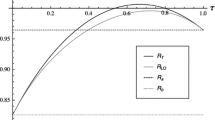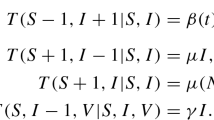Abstract
The basic reproduction number R 0 has been used in population biology, especially in epidemiology, for several decades. But a suitable definition in the case of models with periodic coefficients was given only in recent years. The definition involves the spectral radius of an integral operator. As in the study of structured epidemic models in a constant environment, there is a need to emphasize the biological meaning of this spectral radius. In this paper we show that R 0 for periodic models is still an asymptotic per generation growth rate. We also emphasize the difference between this theoretical R 0 for periodic models and the “reproduction number” obtained by fitting an exponential to the beginning of an epidemic curve. This difference has been overlooked in recent studies of the H1N1 influenza pandemic.
Similar content being viewed by others
References
Aronsson G, Kellogg RB (1978) On a differential equation arising from compartmental analysis. Math Biosci 38: 113–122
Bacaër N, Guernaoui S (2006) The epidemic threshold of vector-borne diseases with seasonality. J Math Biol 53: 421–436
Bacaër N (2007) Approximation of the basic reproduction number R 0 for vector-borne diseases with a periodic vector population. Bull Math Biol 69: 1067–1091
Bacaër N, Ouifki R (2007) Growth rate and basic reproduction number for population models with a simple periodic factor. Math Biosci 210: 647–658
Bacaër N, Abdurahman X (2008) Resonance of the epidemic threshold in a periodic environment. J Math Biol 57: 649–673
Bacaër N, Gomes MGM (2009) On the final size of epidemics with seasonality. Bull Math Biol 71: 1954–1966
Bacaër N (2009) Periodic matrix population models: growth rate, basic reproduction number, and entropy. Bull Math Biol 71: 1781–1792
Bapat RB, Raghavan TES (1997) Nonnegative matrices and applications. Cambridge University Press, London
Berman A, Plemmons RJ (1979) Nonnegative matrices in the mathematical sciences. Academic Press, New York
Boëlle PY, Bernillon P, Desenclos JC (2009) A preliminary estimation of the reproduction ratio for new influenza A (H1N1) from the outbreak in Mexico, March–April 2009. Euro Surveill 14(19):pii=19205
Burlando L (1991) Monotonicity of spectral radius for positive operators on ordered Banach spaces. Arch Math 56: 49–57
Cauchemez S, Valleron AJ, Boelle PY, Flahault A, Ferguson NM (2008) Estimating the impact of school closure on influenza transmission from Sentinel data. Nature 452(7188): 750–754
Coale AJ (1970) The use of Fourier analysis to express the relation between time variations in fertility and the time sequence of births in a closed human population. Demography 7: 93–120
Coale AJ (1972) The growth and structure of human populations, a mathematical investigation. Princeton University Press, Princeton
Degla G (2008) An overview of semi-continuity results on the spectral radius and positivity. J Math Anal Appl 338: 101–110
Diekmann O, Heesterbeek JAP (2000) Mathematical epidemiology of infectious diseases. Wiley, Chichester
Drábek P, Milota J (2007) Methods of nonlinear analysis applications to differential equations. Birkhäuser, Basel
Drnovšek R (2000) Bounds for the spectral radius of positive operators. Comment Math Univ Carol 41: 459–467
Dushoff J, Plotkin JB, Levin SA, Earn DJD (2004) Dynamical resonance can account for seasonality of influenza epidemics. Proc Natl Acad Sci USA 101: 16915–16916
Ediev D (2003) On monotone convergence to stability. Demogr Res 8: 31–60
Feller W (1941) On the integral equation of renewal theory. Ann Math Stat 12: 243–267
Fraser C, Donnelly CA, Cauchemez S et al (2009) Pandemic potential of a strain of influenza A (H1N1): early findings. Science 324: 1557–1561
Grassly NC, Fraser C (2006) Seasonal infectious disease epidemiology. Proc R Soc B 273: 2541–2550
Heesterbeek JAP, Roberts MG (1995) Threshold quantities for helminth infections. J Math Biol 33: 415–434
Inaba H, Nishiura H (2008) The basic reproduction number of an infectious disease in a stable population: the impact of population growth rate on the eradication threshold. Math Model Nat Phenom 3(7): 194–228
Jagers P, Nerman O (1985) Branching processes in periodically varying environment. Ann Probab 13: 254–268
Kato T (1982) Superconvexity of the spectral radius, and convexity of the spectral bound and the type. Math Z 180: 265–273
Kermack WO, McKendrick AG (1927) A contribution to the mathematical theory of epidemics. Proc R Soc A 115: 700–721
Kress R (1999) Linear integral equations, 2nd edn. Springer, New York
Lipsitch M, Viboud C (2009) Influenza seasonality: lifting the fog. Proc Natl Acad Sci USA 106: 3645–3646
Lotka AJ (1939) Théorie analytique des associations biologiques, 2e partie. Hermann, Paris
Michel P, Mischler S, Perthame B (2005) General relative entropy inequality: an illustration on growth models. J Math Pures Appl 84: 1235–1260
Munayco CV, Gomez J, Laguna-Torres VA et al (2009) Epidemiological and transmissibility analysis of influenza A(H1N1)v in a southern hemisphere setting: Peru. Euro Surveill 14(32 pii): 19299
Nakata Y, Kuniya T (2010) Global dynamics of a class of SEIRS epidemic models in a periodic environment. J Math Anal Appl 363: 230–237
Nishiura H, Castillo-Chavez C, Safan M, Chowell G (2009) Transmission potential of the new influenza A (H1N1) virus and its age-specificity in Japan. Euro Surveill 14(22): pii–19227
Perthame B (2007) Transport equations in biology. Birhäuser, Basel
Pourbohloul B, Ahued A, Davoudi B et al (2009) Initial human transmission dynamics of the pandemic (H1N1) 2009 virus in North America. Influenza Other Respi Viruses 3(5): 215–222
Shaman J, Kohn M (2009) Absolute humidity modulates influenza survival, transmission, and seasonality. Proc Natl Acad Sci USA 106: 3243–3248
Thieme HR (1984) Renewal theorems for linear periodic Volterra integral equations. J Integral Equ 7: 253–277
Thieme HR (1998) Remarks on resolvent positive operators and their perturbation. Discret Contin Dyn Syst 4: 73–90
Thieme HR (2009) Spectral bound and reproduction number for infinite population structure and time-heterogeneity. SIAM J Appl Math 70: 188–211
Wang W, Zhao XQ (2008) Threshold dynamics for compartmental epidemic models in periodic environments. J Dyn Differ Equ 20: 699–717
Wesley CL, Allen LJS (2009) The basic reproduction number in epidemic models with periodic demographics. J Biol Dyn 3: 116–129
Williams BG, Dye C (1997) Infectious disease persistence when transmission varies seasonally. Math Biosci 145: 77–88
Author information
Authors and Affiliations
Corresponding author
Rights and permissions
About this article
Cite this article
Bacaër, N., Ait Dads, E.H. Genealogy with seasonality, the basic reproduction number, and the influenza pandemic. J. Math. Biol. 62, 741–762 (2011). https://doi.org/10.1007/s00285-010-0354-8
Received:
Revised:
Published:
Issue Date:
DOI: https://doi.org/10.1007/s00285-010-0354-8




